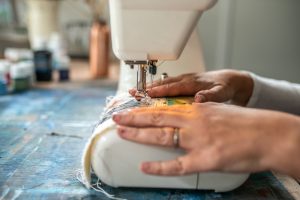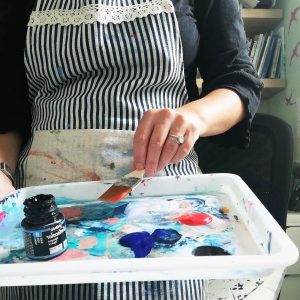
My roots
Growing up in the countryside, I spent a lot of time going off on my own, playing and exploring in the wild. And even though my 20s were very much about ‘city living’ in London, I’ve always been drawn back to the countryside. I currently live in Brighton, which is a happy medium because you can be in the city then it just stops, and suddenly you’re in the countryside. I like the fact that Brighton will never grow – the South Downs National Park is on one side, and the sea is on the other. It’s squished between the two.
When I had a particularly difficult time, I instinctively returned to nature as a way of getting out. I just started going walking, which I’d always done as a kid.
For me, nature is familiar and comfortable, and a place I always turn back to.



An insight into my creative process
Before I put paint to fabric, the first step in my process is getting out in nature, whether it’s up on the Downs or at different coastal locations. I’m generally out walking all the time, not necessarily looking for inspiration, but seeing what’s there or giving ideas the chance to come to me. It could be the way the light is reflecting off the sea, or the look of the mist – it can just be a feeling or a mood. I take lots of photographs to put up on my evolving moodboards, so I can bank all my ideas and have time to develop and play with them.
I always go for dried grasses because, for me, it’s all about being out in the elements. Up on a hillside, the wind, seeing the mist, whatever’s going on. It’s more wild, it’s more natural. It’s about wild botanicals – weeds, grasses – rather than the beauty of a pristine garden. I’ll fill vases and vases with them.
As well as seedheads, I forage for seaweed to press and create stencils and prints in my artwork. And I make interesting marks with pebbles. Wildflowers are just a riot of colour, so I take photos and do a lot of sketching, but I don’t pick them. I often take my oil pastels with me so I can quickly jot down colours and mix them together.
Back in my studio, I use fabric paints and spray paints before the ‘drawing element’ – the embroidery. I never sketch onto my work with pens or pencils, it’s about having the confidence to draw with the sewing machine. Continuous line sketches give my pieces their personality, as I always embrace embroidering freely and drawing larger-than-life botanicals.
At the end, I add finer details and that final layer of texture with tonal hand-stitching (such as French knots). This stage isn’t about drawing, and I don’t like it looking twee!
The challenging part of what I do is making the mixed-media work feel like all the elements belong together. I don’t want anything to feel like it’s ‘plonked on’ for the sake of it. It’s that kind of natural chaos. My work is a bit ethereal, with lots of subtle layers and shadows. I’m trying to portray softness and calmness through my gentle colour palettes.



Why you need nature-inspired work in your home
When bringing the outside in, I want my work to evoke a sense of calm. And with the levels of detailing, my hope is that you’ll always have something new to look at. The details can be quite subtle, but the more you look, the more you see.
‘The subtle colours and detailing provide a calm and interesting focus for my wall. I have two prints and an original painting and they are always admired and commented on. I love the calm quality of Ellie’s work, combined with the beautiful depth of colour and texture.’ – Sue
View gallery of nature inspired artwork
Feeling inspired to get creative?
If you’d like to have a go at textile art yourself, check out the Flourish Textile Art hub. Discover my latest workshops and free resources today!








